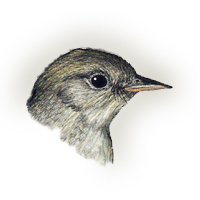|
Field
Guide IDs: BREEDING:
Swamps and thickets
esp willow. 1 brood. DISPLAYS:
Courtship
chase. NEST:
In upright or
slanting fork; compact, of bark, weed stems, grass,
lined with grass, hair, plant down, feathers.
Female selects nest site, accompanied by
male. EGGS:
Buff, occ white,
spotted with browns near large end. 0.7" (18
mm). DIET:
Also few
seeds. CONSERVATION:
Winters from s
Mexico to Panama. Common cowbird host; occ bury
cowbird egg in bottom of nest. Blue List 1980-82,
Special Concern 1986; w coast populations
apparently declining. Populations increase with
reduction of cattle grazing and the cessation of
poisoning and removal of riparian
willows. NOTES:
In contrast to
typical songbirds, song is entirely innate, rather
than learned or partly learned. Females also sing
territorial song. Interspecifically territorial
with Alder Flycatcher in BC and in ne U.S. Rare
polygyny documented. Female broods young for 7-8
days. Formerly known as Traill's Flycatcher, which
included Alder Flycatcher. ESSAYS: Blue
List;
Superspecies;
Vocal
Development;
Sibling
Species;
Interspecific
Territoriality;
Polygyny;
Bills. REFERENCES:
Ettinger and King,
1980; Frakes and Johnson, 1982; Kroodsma, 1984;
Seutin, 1987; Taylor and Littlefield,
1986. |
